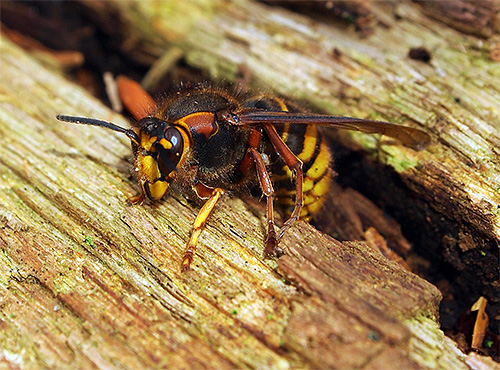
The Hornets' genus is a member of the family The real wasps, and therefore these insects are rightly considered the closest relatives of the common wasps, called in paper for their habit of building nests of young tree bark that was chewed and mixed with saliva. Hornets differ in their way of life, reproduction and feeding mode from ordinary wasps, but, nevertheless, they have some unique features of biology.

Hornets are practically the largest wasps. Only a few scolias and road wasps can rip off these insects in body length. Nevertheless, thanks to its constitution, the hornets can still be considered the most massive representatives of the wasp family.
As a rule, hornets live in any biotopes and are in no way associated with human settlements and agricultural lands. The hornet feeds on different products, but in general these wasps can be characterized as predators.The basis of their diet and food for the brood are other insects, which the hornets catch in large numbers in the territories around their nests.
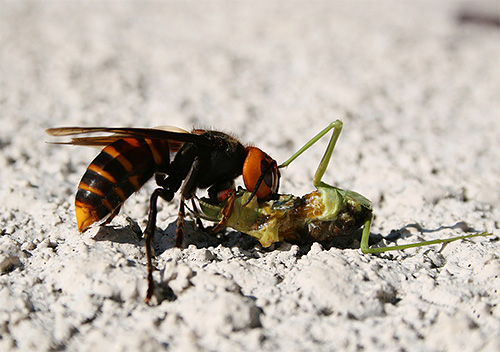
Respectively, where the hornet lives, bee colonies cannot feel safe. That is why these insects are a real disaster for beekeepers.
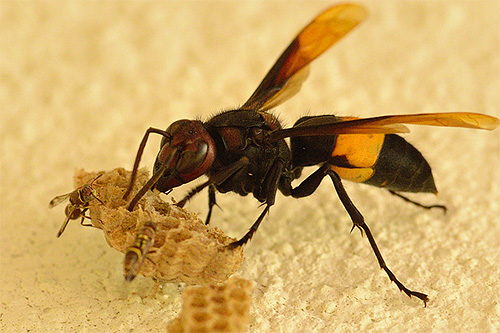
However, in spite of all the above, when large red-headed wasps are regularly found on their land, one should first understand what the hornets feed on, where they live, and only then make a decision on combating these insects.
Where do the hornets live
To date, science is known 23 species of hornets. These insects can be found in many parts of the globe, but most species are common in the Northern Hemisphere. Let us dwell on the most prominent representatives:
- Almost all hornets, which are found on the territory of Russia, belong to the European Hornet. Representatives of this particular species have the greatest similarity with ordinary wasps, but at the same time they can boast larger body sizes.

- For Asia, southern Europe, North Africa, and the Asian part of Russia, the Eastern Hornet is common.This insect has a more original color with a completely brown body and a wide single band on the abdomen.

- Among the many species of hornets there is one endemic. Only in the Philippines can this insect be deadly to humans. The poison of the hornets of this species is so toxic that it occupies almost the first place among all poisonous insects.
European hornets live in forests, groves, in separate thickets of shrubs and in areas occupied by agriculture. The only thing that limits their range is a cold climate in the north and dry biotopes in the south.
Eastern hornets live in other habitats and prefer steppe, semi-desert, passing somewhere in the desert, dry ravines and beams. The Eastern Hornet is practically the only species capable of living in a dry climate.
Hornets live in families nests built by them. Their homes look the same as those of ordinary wasps. Hornet's nest - It is a round-shaped construction of paper honeycombs, suspended on tree branches or placed in hollows, crevices of rocks, various human outbuildings, and sometimes even in distribution or mailboxes.
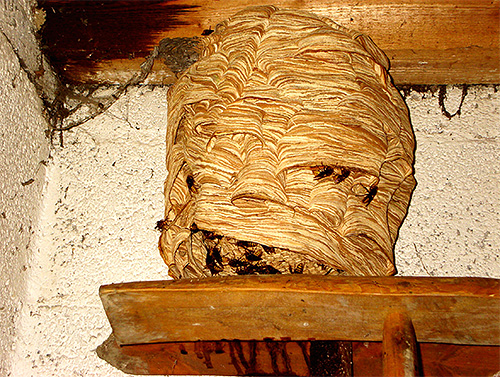
It is interesting
Hornets are capable of causing serious damage to young trees, literally gnawing their upper shoots when collecting bark to build their nest. Particularly affected by the landing of hornets are the ash tree - with an abundance of insects, the tops of the trees can be completely gnawed, due to which the crown stops growing or is formed incorrectly.
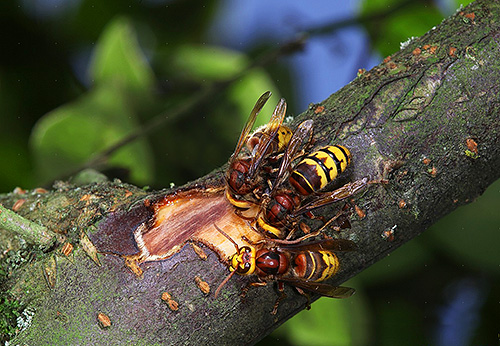
The location of the future nest is determined by the founding female. It winters in any secluded shelter, and in the spring, either directly in it, or in a specially found other place, lays several eggs and feeds the wasps derived from them. After the birth of the young hornets themselves have built a big nest and care for the new brood.
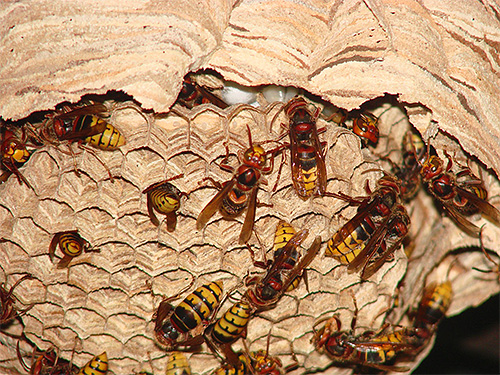

On a note
Hornets love to build nests in the toilets, barns, under the roofs of the verandas and summer kitchens. The reason for this is simple - there is no direct sunlight and drafts, usually quite quietly and calmly. Sometimes nests of hornets were found in cars that had not been used for a long time, inside concrete lighting poles, in chimneys.
Residents of megacities in general are found with these insects much less frequently than residents of rural areas.If you figure out what the hornet eats, it becomes clear why - in a built-up area with high-rise buildings even a relatively small nest cannot always be provided with the right amount of food.
Powering the biggest wasps
Other insects, spiders, worms, centipedes and slugs form the basis of the hornet's diet. Their hornet eats in the nest, carefully dressing and eating the fattest parts. Hornets are fed most of their insects to their larvae - at this stage of the life cycle of the wasp, they are obligate predators, i.e. eat exclusively animal food.

At the same time, adult hornets feed on berry juice (they are not indifferent to blackberries, raspberries and strawberries), sweet soft fruits like peaches and plums, honey, syrup, secretions of aphids, meat and fish. Virtually any strong natural odors of disappearing products attract them. Summer residents should take into account this fact and try to prevent the emergence of such potential food in their area, because even the most common rotting apple can serve as a wonderful feed for the hornet.

A real find for the hornet colony is the honeybee family.Not only are the bees themselves very tasty for hornets, and wasps prey on them, sometimes following up to 5 km, but also the contents of bee dwellings is a no less valuable food resource.
In the looted hive, the hornet feeds on honey and larvae - this is a sufficient source of food for the hornet family for the whole season. It is not surprising that there is a constant war between the hornets and beekeepers.

It is interesting
A giant Asian hornet, reaching a length of 5 cm, can kill up to 40 bees in a minute. A detachment of hornets numbering only 30-40 individuals is able to destroy the entire many thousands of bees in a few hours.
An interesting feature of hornets is that they do not use a sting when they harvest insects, as ordinary wasps do, for example, and kill their victims with powerful jaws. The poison hornet puts into action only for self-defense.

And yet, despite all the trouble that can bring close proximity to the hornet, it is worth to begin to figure out how much the nest, which appeared on the summer cottage, interferes. Hornets - insects are not aggressive, and if you don’t crawl into the nest itself, they will not sting a person.But to destroy a fair amount of pests in the garden hornets are quite capable.
Hornet's Nest Life
Hornets nest at different stages of construction may look different. In the beginning it resembles a pear. Later, the “pear” appears shade, and it becomes like a chandelier.
At the next stage, the construction of the “lampshade” is extended, and its lower edges are closed, again forming a “pear”, but of a much larger size. At all stages of construction in the nest, honeycombs and chambers in which the larvae grow are viewed.
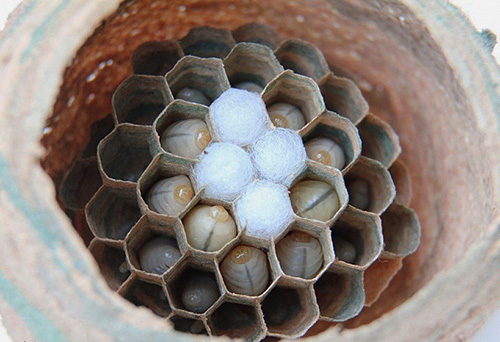
Adult hornets spend only night hours in the nest, and also have a little rest here between raids for fodder or building material. In addition to the hornet-workers, there are several wasps in the nest, which are engaged only in cleaning the honeycombs and caring for the larvae, but they are a minority.
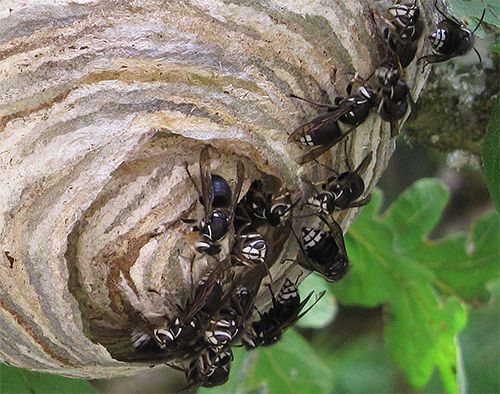
The important moment of the nest's life is that under it constantly accumulate a large number of remains of the victims of the hornets and the dead wasps themselves. In this organic garbage, carrion beetles, ticks and various parasites settle, which, at the end of the nest's existence, get into the honeycomb and hit the family. In many cases, the nest dies precisely under the pressure of parasitic mites.
It is interesting
Staphillin beetles and their larvae almost constantly live in hornet nests. They feed on the remnants of the meal of the hornets, the larvae of their "neighbors" and various waste nests. Regardless of the hornets, these bugs cannot live.
How do hornets breed
Hornets breed in much the same way as other public hymenoptera.
Hornet mating occurs at the end of the warm season of the year - in mid-latitudes it is August-September. By this time, the family becomes quite numerous, and the nest can reach 70 cm in diameter and 1 m in length.
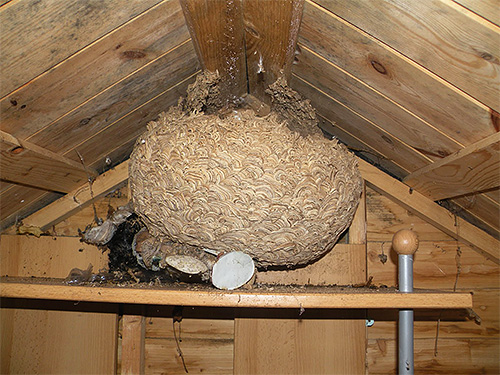
At a certain point, the uterus begins to lay eggs, from which males and females that are already capable of mating are derived (all working hornets are females not capable of breeding).
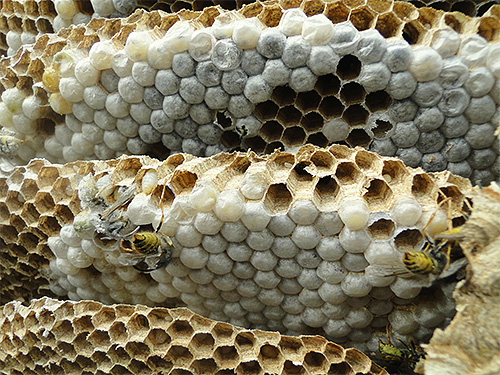
When the number of mature individuals in the nest becomes very large, they fly out, swarm and mate.
After swarming, males die within a few days. The females will never return to their nest, but seek a secluded place for refuge in which they will wait for spring and give rise to a new family.
Working hornets do not live long - about 3-4 weeks. However, many of them die much earlier when they meet with other predators, being eaten by birds or at the hands of humans.
Lifespan hornet uterus is about a year. She usually dies before the second winter in her life, when young females from her family leave the nest.
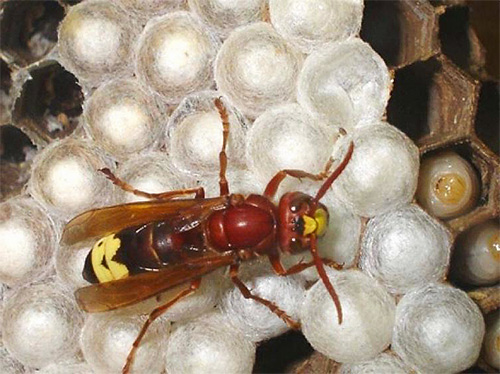
The smallest lifespans are male hornets. They live from a few days to a few weeks - depending on how long before the swarming they appeared.
Wintering: who of the family is going through it?
As mentioned above, hornets hibernate in secluded shelters: the dwellings of other insects, bark crevices, hollows, cracks in rocks, under stones, in rural toilets between boards.

Having dealt with the breeding features of hornets, it can be concluded that only young females winter out of the whole family, ready to start a new family early next year. Old females almost always die before their second wintering, just as males and working hornets do.
It is quite obvious that hornets living alongside human housing cannot be considered uniquely harmful or dangerous insects. They rarely sting, and in general are calm, and sometimes even useful neighbors, because Hornets feed on various pests on our gardens. Only for beekeepers, these insects are unequivocal enemies.
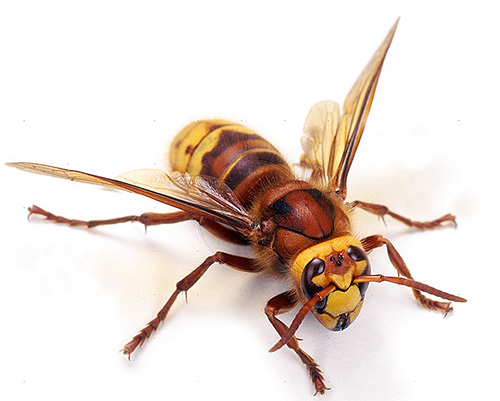
It should also be noted that due to the unjustifiably frequent, useless destruction of nests in many regions of our country, the hornets have become rare, in some places even listed in the Red Book of insects. Therefore, if the hornets' nest is placed in such a way that it doesn’t bother anyone, it should be left alone.
Interesting video: the hornet's uterus begins to build its nest alone
The attack of giant Japanese hornets on a family of honey bees



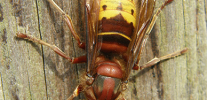
We are already tired of calling a sanitary epidemiological station to bring these creatures. They constantly wind up between the floors, under the balconies in the walls.
Marie, and you - not the creature?
These hornets are so dangerous, I fear them so much! Already trembling through one word ...
And I plant them in a jar, I feed them with grasshoppers and flies.